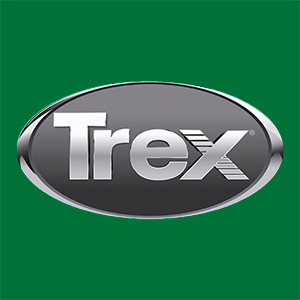
American Woodmark (AMWD)
American Woodmark is in for a bumpy ride. Its low returns on capital and plummeting sales suggest it struggles to generate demand and profits, a red flag.― StockStory Analyst Team
1. News
2. Summary
Why We Think American Woodmark Will Underperform
Starting as a small millwork shop, American Woodmark (NASDAQ:AMWD) is a cabinet manufacturing company that helps customers from inspiration to installation.
- Sales stagnated over the last five years and signal the need for new growth strategies
- Earnings per share have dipped by 6.7% annually over the past five years, which is concerning because stock prices follow EPS over the long term
- Forecasted revenue decline of 3.5% for the upcoming 12 months implies demand will fall even further


American Woodmark doesn’t live up to our standards. There are superior stocks for sale in the market.
Why There Are Better Opportunities Than American Woodmark
High Quality
Investable
Underperform
Why There Are Better Opportunities Than American Woodmark
American Woodmark is trading at $54.74 per share, or 26x forward P/E. Not only is American Woodmark’s multiple richer than most industrials peers, but it’s also expensive for its revenue characteristics.
There are stocks out there featuring similar valuation multiples with better fundamentals. We prefer to invest in those.
3. American Woodmark (AMWD) Research Report: Q3 CY2025 Update
Cabinet manufacturing company American Woodmark (NASDAQ:AMWD) missed Wall Street’s revenue expectations in Q3 CY2025, with sales falling 12.8% year on year to $394.6 million. Its non-GAAP profit of $0.76 per share was 36.5% below analysts’ consensus estimates.
American Woodmark (AMWD) Q3 CY2025 Highlights:
- Revenue: $394.6 million vs analyst estimates of $404.2 million (12.8% year-on-year decline, 2.4% miss)
- Adjusted EPS: $0.76 vs analyst expectations of $1.20 (36.5% miss)
- Adjusted EBITDA: $39.64 million vs analyst estimates of $44.36 million (10% margin, 10.6% miss)
- Operating Margin: 3.1%, down from 9.4% in the same quarter last year
- Free Cash Flow was -$928,000, down from $729,000 in the same quarter last year
- Market Capitalization: $755.4 million
Company Overview
Starting as a small millwork shop, American Woodmark (NASDAQ:AMWD) is a cabinet manufacturing company that helps customers from inspiration to installation.
The company specializes in the design, manufacture, and distribution of kitchen cabinets and vanities for new home construction markets and home renovations. Its products are available through a variety of channels, including home centers, builders, and independent dealers and distributors, catering to a wide customer base.
Its product offerings include kitchen cabinetry, bath cabinetry, office cabinetry, home organization cabinetry, and cabinetry hardware. All of these types of cabinetry are then offered in a variety of designs, finishes, finish colors, and door styles. Its products are available in made-to-order styles (AKA customizable) and stock styles.
Most of the company’s sales are generated through its cabinetry and related product offerings. Its net sales are divided into three categories: sales to home centers such as The Home Depot and Lowes, builders, and independent dealers & distributors. Home center sales generate most of the company’s revenue, with The Home Depot being its top customer. Service revenue from the installation of its products also makes up a portion of its revenue, as the company operates eight strategically placed service centers across the US.
4. Home Construction Materials
Traditionally, home construction materials companies have built economic moats with expertise in specialized areas, brand recognition, and strong relationships with contractors. More recently, advances to address labor availability and job site productivity have spurred innovation that is driving incremental demand. However, these companies are at the whim of residential construction volumes, which tend to be cyclical and can be impacted heavily by economic factors such as interest rates. Additionally, the costs of raw materials can be driven by a myriad of worldwide factors and greatly influence the profitability of home construction materials companies.
Other companies in the cabinetry market include Masco (NYSE:MAS), Fortune Brands Home & Security (NYSE:FBHS), and private company MasterBrand Cabinets.
5. Revenue Growth
Reviewing a company’s long-term sales performance reveals insights into its quality. Any business can put up a good quarter or two, but many enduring ones grow for years. Unfortunately, American Woodmark struggled to consistently increase demand as its $1.60 billion of sales for the trailing 12 months was close to its revenue five years ago. This was below our standards and is a sign of poor business quality.

Long-term growth is the most important, but within industrials, a half-decade historical view may miss new industry trends or demand cycles. American Woodmark’s recent performance shows its demand remained suppressed as its revenue has declined by 9.2% annually over the last two years. 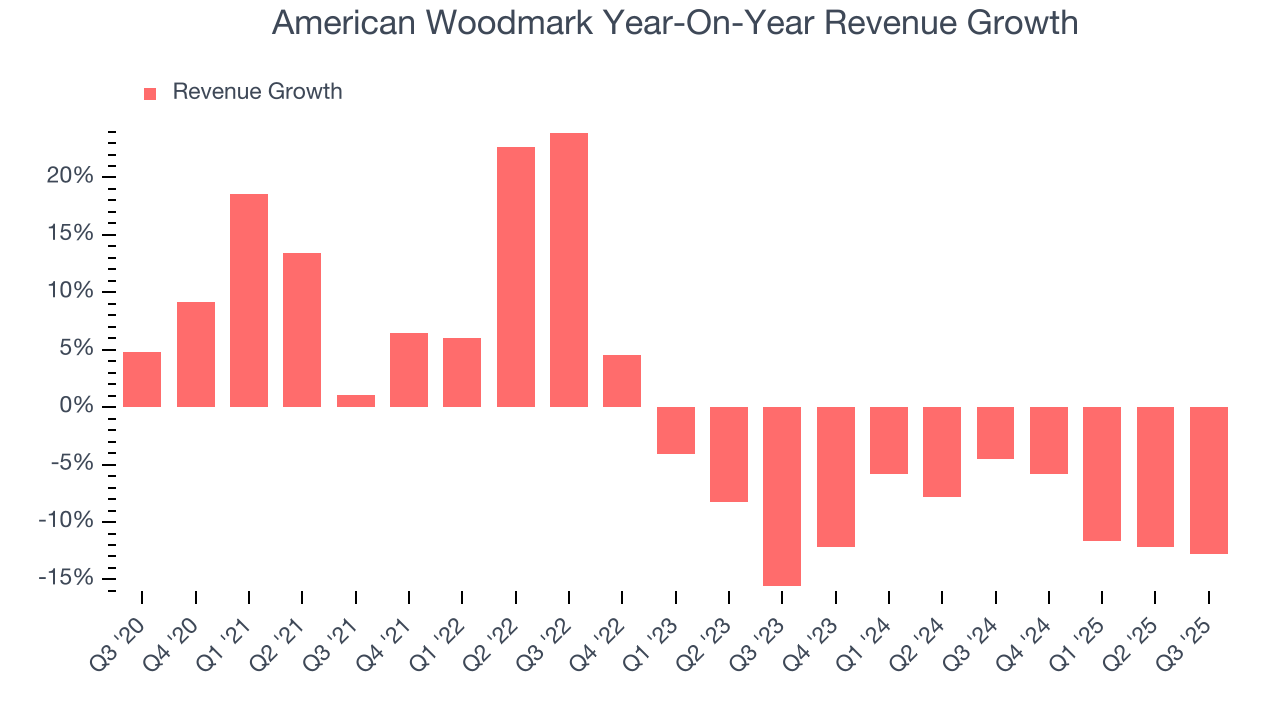
This quarter, American Woodmark missed Wall Street’s estimates and reported a rather uninspiring 12.8% year-on-year revenue decline, generating $394.6 million of revenue.
Looking ahead, sell-side analysts expect revenue to grow 1.3% over the next 12 months. While this projection implies its newer products and services will spur better top-line performance, it is still below average for the sector.
6. Gross Margin & Pricing Power
At StockStory, we prefer high gross margin businesses because they indicate the company has pricing power or differentiated products, giving it a chance to generate higher operating profits.
American Woodmark has bad unit economics for an industrials business, signaling it operates in a competitive market. As you can see below, it averaged a 16.9% gross margin over the last five years. Said differently, American Woodmark had to pay a chunky $83.09 to its suppliers for every $100 in revenue. 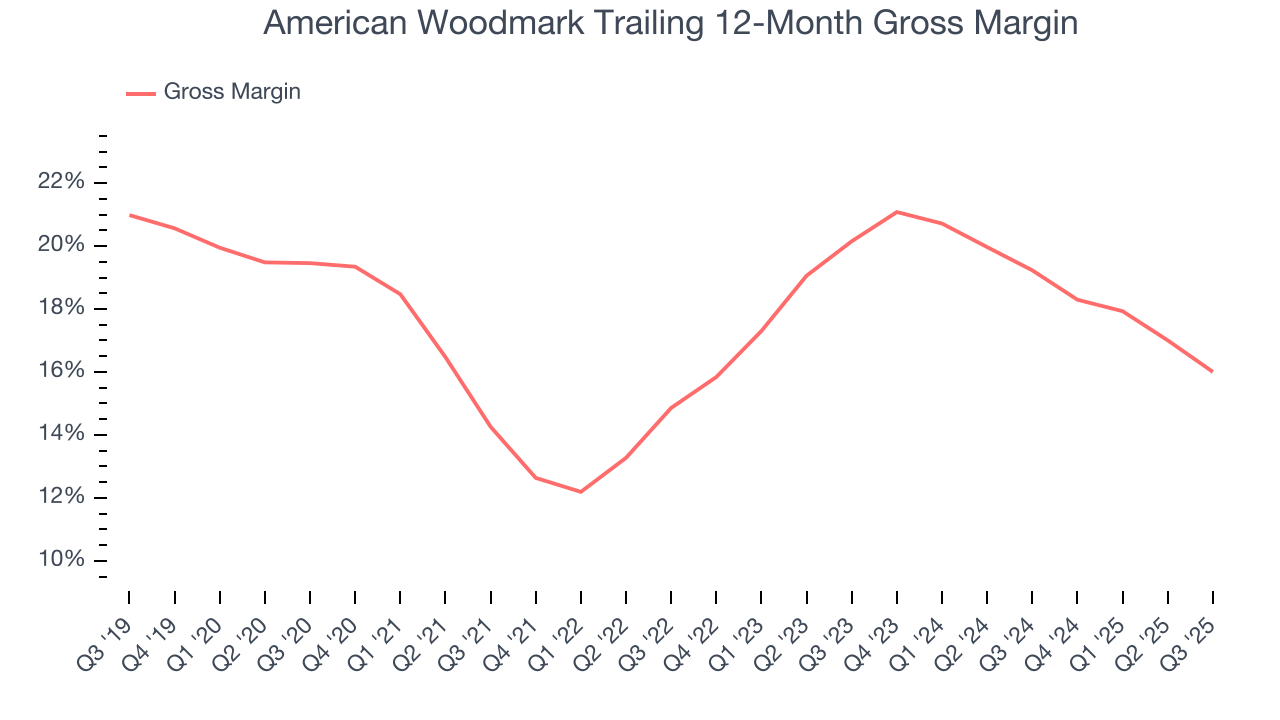
American Woodmark’s gross profit margin came in at 15.2% this quarter, down 3.8 percentage points year on year. American Woodmark’s full-year margin has also been trending down over the past 12 months, decreasing by 3.2 percentage points. If this move continues, it could suggest a more competitive environment with some pressure to lower prices and higher input costs (such as raw materials and manufacturing expenses).
7. Operating Margin
Operating margin is an important measure of profitability as it shows the portion of revenue left after accounting for all core expenses – everything from the cost of goods sold to advertising and wages. It’s also useful for comparing profitability across companies with different levels of debt and tax rates because it excludes interest and taxes.
American Woodmark was profitable over the last five years but held back by its large cost base. Its average operating margin of 6.1% was weak for an industrials business. This result isn’t too surprising given its low gross margin as a starting point.
On the plus side, American Woodmark’s operating margin rose by 1.6 percentage points over the last five years.

This quarter, American Woodmark generated an operating margin profit margin of 3.1%, down 6.3 percentage points year on year. Since American Woodmark’s operating margin decreased more than its gross margin, we can assume it was less efficient because expenses such as marketing, R&D, and administrative overhead increased.
8. Earnings Per Share
Revenue trends explain a company’s historical growth, but the long-term change in earnings per share (EPS) points to the profitability of that growth – for example, a company could inflate its sales through excessive spending on advertising and promotions.
Sadly for American Woodmark, its EPS declined by 6.7% annually over the last five years while its revenue was flat. We can see the difference stemmed from higher interest expenses or taxes as the company actually improved its operating margin and repurchased its shares during this time.
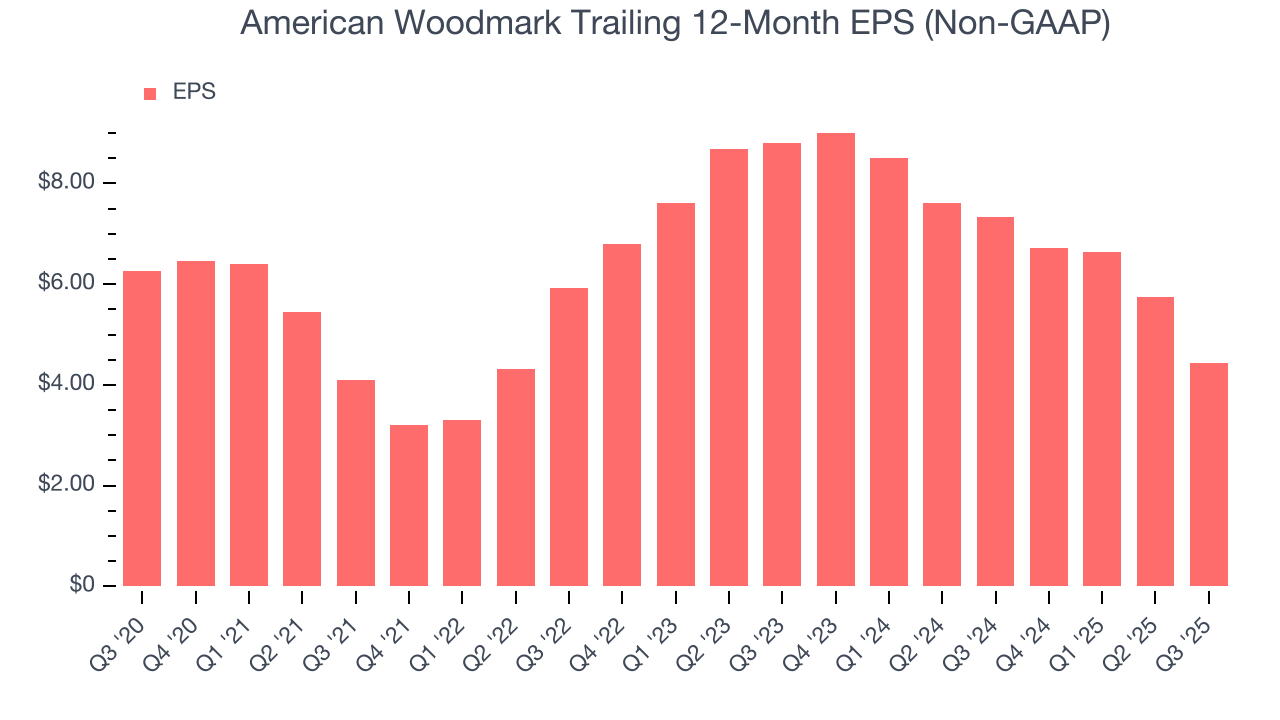
Like with revenue, we analyze EPS over a shorter period to see if we are missing a change in the business.
For American Woodmark, its two-year annual EPS declines of 29.1% show it’s continued to underperform. These results were bad no matter how you slice the data.
In Q3, American Woodmark reported adjusted EPS of $0.76, down from $2.08 in the same quarter last year. This print missed analysts’ estimates. Over the next 12 months, Wall Street expects American Woodmark’s full-year EPS of $4.43 to grow 11.4%.
9. Cash Is King
If you’ve followed StockStory for a while, you know we emphasize free cash flow. Why, you ask? We believe that in the end, cash is king, and you can’t use accounting profits to pay the bills.
American Woodmark has shown weak cash profitability over the last five years, giving the company limited opportunities to return capital to shareholders. Its free cash flow margin averaged 4.4%, subpar for an industrials business.
Taking a step back, an encouraging sign is that American Woodmark’s margin expanded by 3.1 percentage points during that time. The company’s improvement shows it’s heading in the right direction, and we can see it became a less capital-intensive business because its free cash flow profitability rose more than its operating profitability.

American Woodmark broke even from a free cash flow perspective in Q3. This cash profitability was in line with the comparable period last year but below its five-year average. In a silo, this isn’t a big deal because investment needs can be seasonal, but we’ll be watching to see if the trend extrapolates into future quarters.
10. Return on Invested Capital (ROIC)
EPS and free cash flow tell us whether a company was profitable while growing its revenue. But was it capital-efficient? A company’s ROIC explains this by showing how much operating profit it makes compared to the money it has raised (debt and equity).
American Woodmark historically did a mediocre job investing in profitable growth initiatives. Its five-year average ROIC was 6.5%, somewhat low compared to the best industrials companies that consistently pump out 20%+.

We like to invest in businesses with high returns, but the trend in a company’s ROIC is what often surprises the market and moves the stock price. Fortunately, American Woodmark’s ROIC averaged 2.7 percentage point increases over the last few years. This is a good sign, and we hope the company can continue improving.
11. Balance Sheet Assessment
American Woodmark reported $52.07 million of cash and $494.7 million of debt on its balance sheet in the most recent quarter. As investors in high-quality companies, we primarily focus on two things: 1) that a company’s debt level isn’t too high and 2) that its interest payments are not excessively burdening the business.
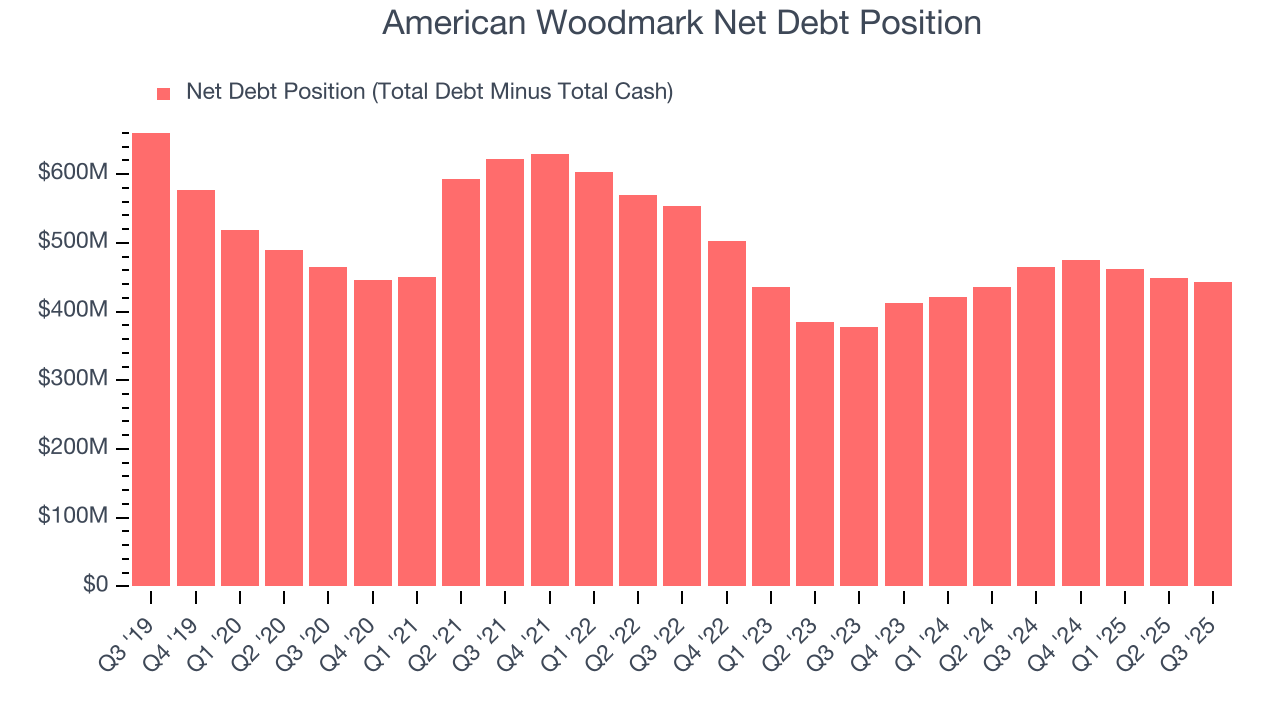
With $167.4 million of EBITDA over the last 12 months, we view American Woodmark’s 2.6× net-debt-to-EBITDA ratio as safe. We also see its $5.21 million of annual interest expenses as appropriate. The company’s profits give it plenty of breathing room, allowing it to continue investing in growth initiatives.
12. Key Takeaways from American Woodmark’s Q3 Results
We struggled to find many positives in these results. Its revenue missed and its EBITDA fell short of Wall Street’s estimates. Overall, this was a softer quarter. The stock traded up 5.8% to $54.86 immediately after reporting.
13. Is Now The Time To Buy American Woodmark?
Updated: December 24, 2025 at 11:02 PM EST
Are you wondering whether to buy American Woodmark or pass? We urge investors to not only consider the latest earnings results but also longer-term business quality and valuation as well.
We cheer for all companies making their customers lives easier, but in the case of American Woodmark, we’ll be cheering from the sidelines. To begin with, its revenue growth was weak over the last five years, and analysts expect its demand to deteriorate over the next 12 months. And while its rising cash profitability gives it more optionality, the downside is its projected EPS for the next year is lacking. On top of that, its declining EPS over the last five years makes it a less attractive asset to the public markets.
American Woodmark’s P/E ratio based on the next 12 months is 26x. This valuation tells us a lot of optimism is priced in - we think there are better opportunities elsewhere.
Wall Street analysts have a consensus one-year price target of $64.50 on the company (compared to the current share price of $54.74).
Although the price target is bullish, readers should exercise caution because analysts tend to be overly optimistic. The firms they work for, often big banks, have relationships with companies that extend into fundraising, M&A advisory, and other rewarding business lines. As a result, they typically hesitate to say bad things for fear they will lose out. We at StockStory do not suffer from such conflicts of interest, so we’ll always tell it like it is.







